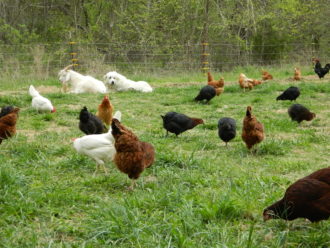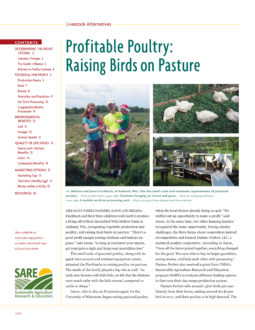
Industry Changes
Raising poultry on pasture isn’t exactly new. Most broilers, layers and other domesticated fowl were raised outdoors before the advent of the now-dominant confinement method in the late 1950s.
Since then, large corporations have become the primary producers of poultry in the United States, developing “vertically integrated” practices that allow them to capture nearly 100 percent of the multi-billion dollar annual market. Today, vertically integrated corporations control almost every aspect of how broilers and eggs are produced, processed and sold. Individual farmers still participate in these large-scale systems, but as contractors who agree to meet standards that usually include furnishing climate-controlled confinement houses to hold tens of thousands of birds or more. An individual confinement house can cost more than $200,000. Poultry companies usually supply farmers with chicks and feed needed to bring them to market weight in seven weeks or less. The vertically integrated corporations then typically manage the slaughtering and packaging process, paying contract farmers by the bird, with feed and heating costs factored into the equation. The system has helped make chicken a low-cost staple for American consumers.
But some farmers and consumers question whether, in the process of achieving that efficiency, values they consider important—autonomy and independence for farmers, the welfare of the flocks, and the taste and quality of their meat and eggs—have been lost. To meet growing demand for poultry raised differently, a number of growers, especially those on small- or mid-scale diversified farms, are choosing to raise birds in alternative ways, most of them reliant upon pasture.
Before taking the plunge, consider...
- In penned systems, expect to move pens daily. Other approaches can be less physically demanding. See Alternative Poultry System Examples.
- Poultry operations are usually seasonal, unless producers build semi-permanent housing. See Yarding.
- You may need to dig to find suppliers such as hatcheries and other contractors. Yet, those retailers will likely ship materials to you.
- Pastured birds are susceptible to weather-related stress and predation.
- Reliable processing may be hard to find; many farmers process on site.
- While some are concerned that pastured poultry might be exposed to avian influenza through migratory waterfowl, others claim that flocks and pasture managed with care to avoid parasites are at less risk than large confinement houses.
“One of our key findings is that the system has real advantages on diversified farms,” said researcher George “Steve” Stevenson, director of the Center for Integrated Agricultural Systems (CIAS) at the University of Wisconsin, who was awarded a grant from SARE. “What’s really nice about pastured poultry is that it folds in with a whole range of other enterprises.”
For example, Rick and Marilyn Stanley of Wells, Maine, have found that poultry and high-value vegetable production can mix well together. The Stanleys raise certified organic vegetables and laying hens on their historic New England farm. One of the most valuable crops the Stanleys raise is asparagus. They received a SARE grant to experiment with integrating hens into their asparagus production to control quackgrass and other problematic weeds. They examined weed growth in the asparagus beds both with and without the hens. After two years they concluded that the hens did a great job. “We’re happy with the job the hens did, and we’re planning on continuing to use them,” said Marilyn. “The hens are worth keeping for the labor savings alone because we spend so much less time hand weeding the asparagus.”
Terrell Spencer, a Nebraska pastured-poultry producer and sustainable poultry specialist with the National Center for Appropriate Technology (NCAT), said that historically farmers raised poultry not only for meat, eggs and feathers, but also as a management tool. “From the Southern tradition of using Cotton Patch and other geese to weed cotton and strawberry fields to American colonists running turkeys in the fields to manage tobacco worms, poultry are extremely versatile on the farm,” said Spencer. An increasingly popular method of fly control is to follow cattle with laying hens in portable housing, a method invented by pastured-poultry pioneer Joel Salatin. The laying flock tears apart the cow patties while searching for the parasitic fly larvae that live in the dung. The hens have a drastic effect on fly populations, leading to happier and less-stressed cattle, and increased gains and profits. “The more uses you can get out of your flocks, the more profitable they become,” said Spencer.
In Wisconsin, the Fischbachs have also found ways to mix vegetables and pastured poultry on their farm. Besides poultry, they raise tomatoes, peppers and other vegetables in high tunnels. “By November, the crops are getting pretty rough,” said Jason, “so we move the Thanksgiving turkeys into the high tunnels. The turkeys clean and fertilize the tunnels up pretty nice, and the tunnels help keep the turkeys dry and out of the wind as the cold sets in before Thanksgiving.”
The Salatin Influence: Pastured Poultry Takes Off
Since poultry farmers began looking for alternatives, innovators have responded by perfecting various systems, many of them outdoors, that raise chickens for greater profit with less environmental impact and better conditions for the birds. The ways to raise poultry are varied to meet producers’ goals and take into account climate, topography and available labor.
In the early 1990s, Virginia farmer Joel Salatin published a book detailing a new system to compete for the small but growing niche of consumers who wanted to buy poultry raised outside the corporate system. His popular Pastured Poultry Profits explains the innovations he made to the old practice of allowing poultry to range free around the barn lot. The book lays out production strategies alongside his estimates of what readers who follow his methods can net: $25,000 in only six months on 20 acres.
In his system, producers raise or buy chicks between April and October, then move them from brooders into floorless pens on pasture. Today, pastured-poultry pens are built in an ingenious array of shapes and sizes, and with different materials and engineering. If put side by side, a lineup of these homegrown pens would look much like a boxcar derby, each reflecting a farmer’s creative ability to design according to a particular farm’s needs and terrain. Salatin’s pens are around 10 feet by 12 feet by 2 feet, flat-roofed, squat and square, and can house up to 80 broilers. He moves the pens daily to fresh pasture. While receiving exercise and fresh air foraging for plants and insects, the chickens drop manure that adds fertility to the soil.
Salatin passes along his experiences and ideas, holding field days and speaking frequently at conferences. With help from SARE and Heifer International, a nonprofit organization that promotes community development through sustainable livestock production, Salatin held workshops for limited-resource farmers interested in learning more about pastured poultry.
“You walk away from three days with [Salatin] knowing everything from how to keep a chicken healthy to how to keep your customers happy,” said Rosa Shareef, a farmer from New Medinah, Miss., who attended one of the workshops.
Tom Delehanty, a former conventional chicken farmer in Wisconsin, who moved to Socorro, N.M., to raise pastured poultry, credits Salatin’s methods for providing a jumping-off point from which he designed a field pen to fit his New Mexico climate. There, mild desert winters allow him to keep birds on pastures year-round.
